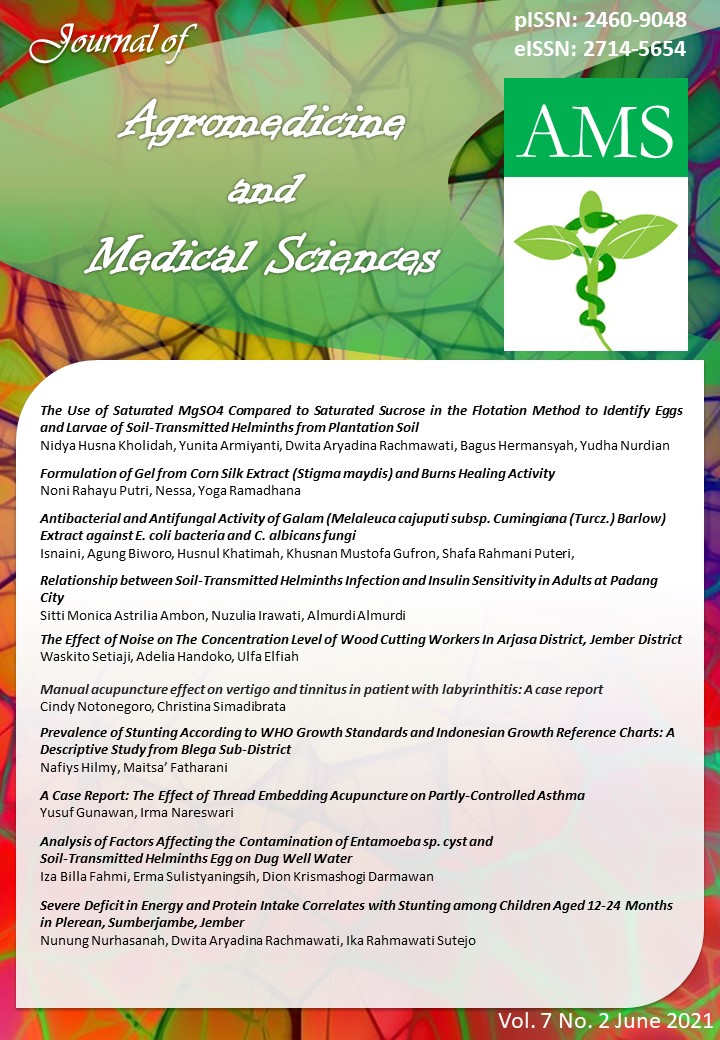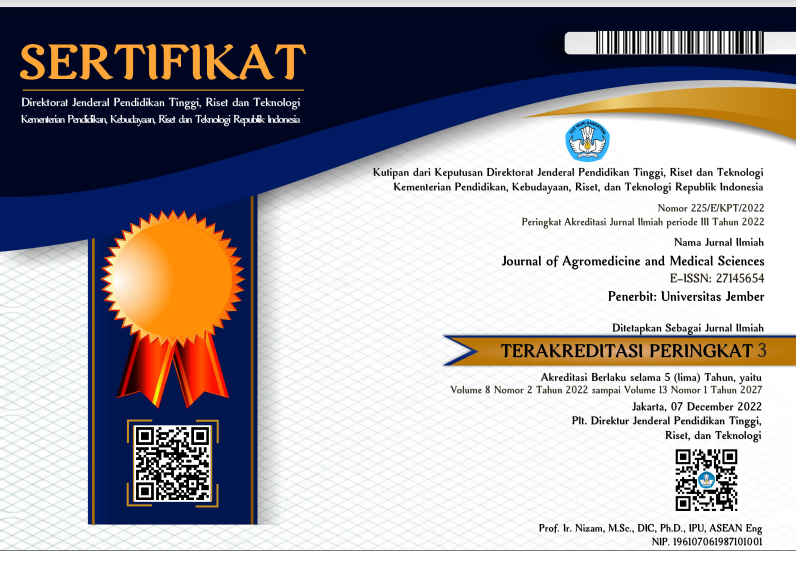Prevalence of Stunting According to WHO Growth Standards and Indonesian Growth Reference Charts: A Descriptive Study from Blega Sub-District
DOI:
https://doi.org/10.19184/ams.v7i2.23868Abstract
Stunting is one of the remaining health issues in Indonesia and its prevalence was still high in the last decades. There are two types of growth charts that can be used in recording the child's growth: growth standards and growth references. In recent times, the selection of the suitable growth charts has become a subject of discussion in many countries. The objective of this study is to describe the prevalence of stunting according to World Health Organization Child Growth Standards (WHOCGS) and Indonesian National Growth Reference Charts (INGRC) of children under five from the Blega sub-district. The secondary data from 2884 children were collected recapitulation of the 'Bulan Timbang' program in February 2020. Z-score of length/height-for-age was plotted according to WHOCGS and INGRC. The result showed that the prevalence of stunting were lower for the INGRC than WHOCGS (5.83% and 11.17%, with p-value <0.001). There was an advantage and disadvantage when using both two growth charts. Further research is still needed to support the result of this study.
Keywords: Stunting, World Health Organization Child Growth Standards, Indonesian National Growth Reference Charts
Downloads
References
Badan Pusat Statistik (BPS) dan Kementrian Kesehatan RI. (2017). Laporan Pelaksanaan Integrasi Susenas Maret 2019 dan SSGBI tahun 2019. Badan Pusat Statistik. Jakarta
Christesen, H. T., Pedersen, B. T., Pournara, E., Petit, I. O., & JúlÃusson P.B. (2016). Short stature: Comparison of WHO and National Growth Standards/References for Height. PLoS ONE. 11(6): e0157277. https://doi.org/10.1371/journal.pone.0157277
Cole, T.J. (2012). The development of growth references and growth charts. Ann Hum Biol. 39:382-94. https://doi.org/10.3109/03014460.2012.694475
De Onis, M., & Branca, F. (2016). Childhood stunting: a global perspective. Matern Child Nutr, 12:12–26. https://doi.org/10.1111/mcn.12231
De Onis, M., Onyango, A., Borghi, E., Siyam, A., Blössner, M., & Lutter, C. (2012). Worldwide implementation of the WHO Child Growth Standards. Public Health Nutrition, 15(9), 1603-1610. https://doi.org/10.1017/S136898001200105X
Flynn, J., Alkaff, F. F., Sukmajaya, W. P., & Salamah, S. (2020). Comparison of WHO growth standard and national Indonesian growth reference in determining prevalence and determinants of stunting and underweight in children under five: a cross-sectional study from Musi sub-district [version 3; peer review: 2 approved]. F1000Research, 9:324 https://doi.org/10.12688/f1000research.23156.3
Galdeanoa, P. A., Abad, M. M., Alonsoa, A. A, Irureta S. J., Goikoetxea BC, Ruiz SG, et al. (2020). Effect of changing reference growth charts on the prevalence of short stature. An Pediatr (Barc). 92(1): 28-36. https://doi.org/10.1016/j.anpedi.2019.03.006
Hong, S. A., Mongkolchati, A., Chompikul, J., Mo-Suwan, L., & Choprapawon, C. (2016). Comparison of prevalence of nutritional status of Thai children in the first 2 years of life using national and international growth charts. J Med Assoc Thai. 99 (1): 58-64. PMID: 27455825.
Hui, L. L., Schooling, C. M., Cowling, B. J., Leung, S. S., Lam, T. H., & Leung, G. M. (2008). Are universal standards for optimal infant growth appropriate? Evidence from a Hong Kong Chinese birth cohort. Archives of disease in childhood, 93(7), 561–565. https://doi.org/10.1136/adc.2007.119826
Ikatan Dokter Anak Indonesia (IDAI). (2017). Panduan Praktik Klinis Ikatan Dokter Anak Indonesia: Perawakan Pendek pada Anak dan Remaja di Indonesia. Badan Penerbit Ikatan Dokter Anak Indonesia. Jakarta
Johnson, W., Vazir, S., Fernandez-Rao, S., Kankipati, V. R., Balakrishna, N., & Griffiths, P. L. (2012). Using the WHO 2006 child growth standard to assess the growth and nutritional status of rural south Indian infants. Annals of Human Biology 39(2):91-101. https://doi.org/10.3109/03014460.2012.657680
Kementrian Kesehatan Badan Penelitian dan Pengembangan Kesehatan. (2018). Laporan Nasional Riskesdas 2018. Kemenkes RI. Jakarta
Khadilkar, V., & Khadilkar, A. (2011). Growth charts: a diagnostic tool. Indian J Endocr Metab. 15(3): 166-171. https://doi.org/10.4103/2230-8210.84854
Khadilkar, V. V., Khadilkar, A. V., & Chiplonkar, S. A. (2010). Growth performance of affluent Indian preschool children: a comparison with the new WHO growth standard. Indian Pediatr 47: 869-872. https://doi.org/10.1007/s13312-010-0147-6
Natale, V., & Rajagopalan, A. (2014). Worldwide variation in human growth and the world health organization growth standards: a systematic review. BMJ Open. 4:e003735. https://doi.org/10.1136/bmjopen-2013-003735
Novina, Hermasnussen, M., Schefffler, C., Pulungan, A. B., Ismiarto, Y. D., Andriyana, Y., et al. (2020). Indonesian National growth reference charts better reflect height and weight of children in West Java, Indonesia, than WHO child growth standards. J Clin Res Pediatr Endocrinol. 12(4):410-419. https://doi.org/10.4274/jcrpe.galenos.2020.2020.0044
Padula, G., Seoane, A. I., & Salceda, S. A. (2012). Variations in estimates of underweight, stunting, wasting, overweight and obesity in children from Argentina comparing three growth charts. Public Health Nutr. 15(11): 2086–2090. https://doi.org/10.1017/S136898001200095X
Parsons, H. G., George, M. A., & Innis, S. M. (2011). Growth Assessment in clinical practice: whose growth curve? Curr Gastroenterol Rep. 13:286–292 PLoS ONE 8(8): e70871. https://doi.org/10.1007/s11894-011-0187-7
Peraturan Menteri Kesehatan. (2020). Peraturan Menteri Kesehatan (PMK) Republik Indonesia Nomor 2 Tahun 2020 Tentang Standar Antropometri Anak.
Pulungan, A. B. (2020). Auxology, Kurva Pertumbuhan, Antropometri, dan Pemantauan Pertumbuhan. Sari Pediatri 22(2):123-130. http://dx.doi.org/10.14238/sp22.2.2020.123-30
Pulungan, A. B., Julia, M., Batubara, J. R. L, & Hermanussen, M. (2018). Indonesian National Synthetic Growth Charts. Acta Scientific Paediatrics. 1.1: 20-34.
Scheffler, C., Hermanussen, M., Bogin, B., Liana, D. S., Taolin, F., Cempaka, P., et al. (2019). Stunting is not a synonym of malnutrition. Eur J Clin Nutr. 74:377-386. https://doi.org/10.1038/s41430-019-0439-4
Scherdel, P., Botton, J., Rolland-Cachera, M-F., Léger, J., Pelé, F., Ancel, P. Y., et al. (2015). Should the WHO growth charts be used in France? PLoS ONE 10(3): e0120806. https://doi.org/10.1371/journal.pone.0120806
Scherdel, P, Salaün, J. F., Robberecht-Riquet, M. N., Reali, L., Páll, G., Jäger-Roman, E., et al. (2013). Growth monitoring: a survey of current practices of primary care paediatricians in Europe. Plos ONE 8(8): e70871. https://doi.org/10.1371/journal.pone.0070871
Stewart, C. P., Iannotti, L., Dewey, K. G., Michaelsen, K. F., & Onyango, A. W. (2013). Contextualising complementary feeding in a broader framework for stunting prevention. Matern Child Nutr. 9:27-45. https://doi.org/10.1111/mcn.12088
Tanjung, C., Prawitasari, T., & Sjarif, D. R. (2020). Comments on “Stunting is not a synonym of malnutritionâ€. Eur J Clin Nutr. 74, 527–528. https://doi.org/10.1038/s41430-020-0570-2
Tim Nasional Percepatan Penanggulangan Kemiskinan. (2017). 100 Kabupaten/Kota Prioritas untuk Intervensi Anak Kerdil (Stunting): Ringkasan. Sekretariat Wakil Presiden Presiden Republik Indonesia. Jakarta
World Health Organization (WHO). (2015). Nutrition: Stunting in a nutshell. https://www.who.int/nutrition/healthygrowthproj_stunted_videos/en/ (diupdate 19 November 2015; diakses pada 15 Januari 2021).
World Health Oorganization (WHO) Multicentre Growth Reference Study Group. (2006). Assessment of differences in linear growth among populations in the WHO Multicentre Growth Reference Study. Acta Paediatr. Supp 450:56-65. https://doi.org/10.1111/j.1651-2227.2006.tb02376.x
Yang, Z., Duan, Y., Ma, G., Yang, X., & Yin S. (2015). Comparison of the China growth charts with the WHO growth standards in assessing malnutrition of children. BMJ Open. 5(2): e006107. https://doi.org/10.1136/bmjopen-2014-006107
Zorlu, G. (2011). New WHO child growth standards catch on. Bull World Health Organ. 89(4): 250–1. https://doi.org/10.2471/BLT.11.040411






















